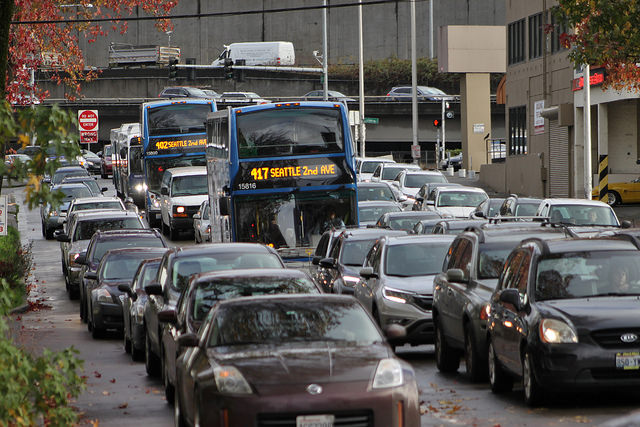
Note: This article was originally a guest post in the Seattle Transit Blog.
If done right, congestion pricing can reduce pollution and improve mobility.
Seattle has a traffic problem. According to the 2018 Global Traffic Scorecard, Seattle is the 6th most congested city in the country, robbing people who drive 138 hours and nearly $2,000 annually.
Congestion also contributes to our climate crisis, with 66% of Seattle’s greenhouse gas emissions coming from road transportation. Commutes will only get longer and pollution worse as our city grows unless we take decisive action. Cities across the world, facing similar dilemmas, are considering congestion pricing, the only proven tool to reduce congestion. Pricing is also a tool that can be used to achieve other outcomes like mitigating local air and water pollution, and creating progressive revenue structures to support healthier and safer mobility options. While cordon pricing, charging people to drive to or within a downtown area, is the most well-known form of congestion pricing, pricing is flexible and we can find a structure that best meets our goals.
Last Thursday, the City of Seattle released a congestion pricing phase one report that provides case studies and potential pricing tools to inform Seattle’s policy development and engagement process as we explore congestion pricing. The report evaluates a variety of possible pricing scenarios based on criteria related to equity, climate and health, traffic congestion, and implementation, and outlines a process for engaging with stakeholders to ensure benefits accrue to communities who need them most. We all now have an opportunity to help shape a progressive plan that is still in the early stages of policy development.
Transportation Choices Coalition is working to bring more and better transportation choices to Washington State, improving access and mobility for all. As the report identifies, our current transportation system is inequitable, drawing from regressive revenue sources, struggling to provide affordable and reliable options to those pushed out by growth, and creating poor air quality disproportionately in communities of color. We believe that if done right, congestion pricing has the ability to cut pollution and greenhouse gas emissions, and generate progressive revenue to reinvest in a robust transportation system. There are understandable concerns that a poorly planned pricing system could hurt low-income communities and communities of color, and our priority is to develop a congestion pricing policy rooted in equity.
Here’s what we want to see next from Seattle’s congestion pricing process:
- Equitable engagement process with a broad coalition. The only path to an equitable policy is an inclusive process. Using best practices from the City’s Racial Equity Toolkit to support and incorporate community input, a strong outreach program will help identify strategies that ensure community concerns are met, such as privacy, language and technology barriers, and affordability. A broad and regional coalition of business, labor, social justice, environmental, health, and transportation organizations must come together to help shape the policy.
- Robust transportation choices are in place on day one. To provide real alternatives to driving downtown, a richer set of transportation services and infrastructure must be in place before pricing begins. Investments made now in expanding regional public transit service create better access and offer people an affordable and reliable set of options. Data and engagement will help us understand priority investment areas.
- Progressive pricing system. To understand the impacts of congestion pricing on workers, low-income people and communities of color, it is important to have a robust understanding of who currently drives downtown, especially during peak hours. Displacement continues to push people further away from the city center, and it’s critical to build a fair policy that ensures those with long commutes and few transit options are able to access the opportunities Seattle’s downtown provides. This means implementing a truly progressive pricing plan. To truly advance transportation equity, not just mitigate harm, policy development should explore the extent to which new revenue could replace regressive transportation funding mechanisms like sales tax.
- Reinvestment in sustainable transportation. Congestion pricing revenue should be directed towards funding an accessible and affordable transit, walking, and biking networks, connecting our transportation system throughout the region.
Streets are not free. They are built and maintained at a significant public expense and externalities in the form of air and stormwater pollution, traffic collisions and serious injuries, and lost time spent in traffic. It’s time we better manage our limited road space through a progressive pricing plan and invest in a sustainable multimodal transportation system that serves everyone.
Transportation Choices Coalition is working to bring Washingtonians more and better transportation choices — real opportunities to take a bus, catch a train, ride a bike, or walk.




